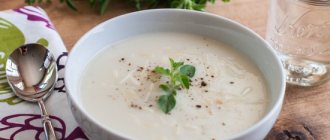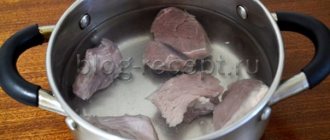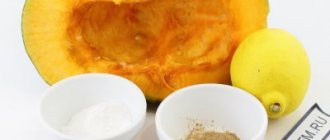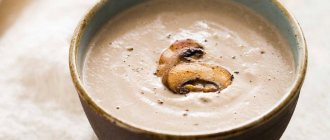Selecting and preparing cauliflower
Before making puree, you should definitely familiarize yourself with some nuances when choosing a vegetable, especially if you are going to feed it to your baby.
- First of all, forget about the frozen product, especially if it is not homemade. You only need fresh cabbage.
- Touch the head of cabbage, it should be quite dense and elastic.
- The color of a good vegetable is light beige. In this case, all inflorescences should be in close contact with each other.
- The fruit should not be darkened or damaged.
Once a head of cabbage has been selected, it’s time to consider how and how much to cook cauliflower for baby puree, as well as how to prepare a tasty dish for adults.
Pros and cons of cauliflower as a first food
For the first complementary feeding, cauliflower is used due to the following positive aspects:
- low risk of allergic reaction;
- babies like the taste of vegetables;
- the gastrointestinal tract easily absorbs the product;
- inflorescences contain less fiber than regular cabbage, and therefore do not cause flatulence;
- the dish contains a large number of microelements;
- the vegetable contains many useful vitamins that strengthen the baby’s immunity;
- beneficial effect on the liver and gall bladder;
- strengthening bones;
- improvement of general metabolic processes;
- the plant has a beneficial effect on blood vessels;
- The vegetable helps reduce blood glucose (prevention of diabetes).
However, in addition to its advantages, cauliflower also has disadvantages. It is difficult to prepare this vegetable, especially while maintaining maximum sterility of the product. The inflorescences are quite difficult to wash, and they contain a lot of sand and earth. In addition, an excess of vegetables has a negative effect on the gastrointestinal tract and kidneys. The baby may experience: rashes, disturbances in the functioning of the kidneys and stomach, bloating and changes in stool. Therefore, when introducing complementary foods, parents should carefully adhere to the recommended amount of food.
Cauliflower puree for babies
The recipe for cauliflower puree for babies is not much different from the usual method of preparing it. You just need to carry out some preliminary steps.
Required Products:
- head of cabbage;
- two tablespoons of salt;
- water - how much will go.
Cooking process:
- Be sure to separate the cabbage into inflorescences, then rinse them under cool water.
- After this, you need to soak them in a saline solution. Pour the specified amount of salt into one liter of water, dissolve it and place large inflorescences there for 30 minutes.
- After this time, rinse them again under water and disassemble them into smaller parts.
- Bring water to a boil on the stove and place the cabbage in it. There is no need to salt it. Cook for about 15 minutes until soft.
- Then puree the inflorescences in a blender and you can additionally pass the resulting mass through a sieve.
Making puree at home
There are parents who only accept home-prepared complementary foods. Indeed, homemade food has advantages: mom doesn’t have to worry about quality and cooks exactly as much as needed every time.
You can buy fresh or frozen cauliflower. In the second case, pay attention to the amount of ice and the indicated shelf life. There are fewer vitamins in a frozen product, so use fresh vegetables whenever possible.
- Choose ivory-colored specimens without black spots or other visible damage.
- Tear off small inflorescences from the head of cabbage and leave in water for 20 minutes to get rid of possible insects. Before preparing complementary foods, it is recommended to leave store-bought cabbage in cool boiled water for 4 hours: during this time, pesticides and other harmful substances will leave it.
- Rinse the inflorescences thoroughly and brush with a brush under running water, then disassemble into components.
- Throw into boiling water and cook for 7-10 minutes, preferably in an enamel bowl. No need to add salt.
- Grind in a blender or with a fork, then rub through a special strainer for complementary feeding.
- The consistency should be approximately like that of kefir, otherwise the child may refuse complementary feeding. Bring the finished puree to the required thickness with vegetable broth or breast milk. Infant formula is also an option.
Prepare a new portion for each meal. Preparing puree in a slow cooker will take 25 minutes, in a double boiler - at least 15 minutes with the correct mode, in a microwave oven - 7-10 minutes, depending on the power.
With added broccoli
Cauliflower and broccoli puree provides twice the benefits. This dish can be prepared not only on the stove, but also in a slow cooker or double boiler.
Required Products:
- 350 grams of broccoli;
- spices to taste;
- two tablespoons of butter;
- 700 grams of cauliflower.
Cooking process:
- Bring the water to a boil, add salt, add the disassembled cauliflower and boil for about four minutes.
- After this time, add the broccoli and continue cooking for another three minutes.
- Drain the remaining liquid, puree the cabbage with a blender, add seasonings to taste and oil. Stir the finished puree and serve with croutons.
Tips for introducing complementary foods
If a breastfeeding mother eats cauliflower, it means that the baby is already familiar with it through breast milk. The reaction to the vegetable should be positive. Often, such babies begin to be fed this vegetable from six months.
Infants who are on artificial nutrition are introduced to vegetable delicacies a little earlier - at 4.5-5 months. Before this, feeding cabbage is not recommended, since the baby’s stomach is still very weak and may not be able to digest the product.
For the first time, you should give half a teaspoon of puree. It is advisable to introduce your child to a new dish in the morning or afternoon. Throughout the day you need to monitor your baby to see if there is any reaction to the newly introduced product.
Even if the body has accepted a new dish, and the baby’s reaction is also positive, you no longer need to feed him this dish throughout the day. Everything should be in moderation.
After a few days, you can prepare the puree again, each time increasing the portion by half a teaspoon. After a month they reach the norm of 50 grams per day. If your baby consumes cabbage puree for a month, it is recommended to add a drop of unrefined vegetable oil to it. You can add different oils: olive, flaxseed, corn, nut. Your child will let you know by his reaction to purees which oil he likes the food with the most.
Vegetable puree with potatoes
If you want some more serious and rich food, then prepare mashed cauliflower and potatoes. This dish is perfect for a filling lunch.
Required Products:
- a small head of cauliflower;
- seasonings to taste;
- three potatoes;
- 50 grams of butter.
Cooking process:
- Peel the potatoes, wash the cabbage and divide into small parts.
- Place all the vegetables in a pan of salted water as soon as it boils. Cook for about 10 - 15 minutes until the food becomes soft.
- Drain the excess liquid, puree the ingredients using a blender, season with spices and oil.
How to freeze vegetables for complementary feeding for the winter
You can often hear that when exposed to temperature, no vitamins or nutrients remain in frozen vegetables. Moreover, it is necessary to add preservatives to preserve food. In fact, this is a myth.
Frozen vegetables retain all the same vitamins and minerals as fresh ones. The only difference is that bacteria that cause rotting cease their activity when there is a sharp change in temperature.
Therefore, as soon as you defrost the vegetables, do not put off preparing puree for complementary feeding for too long.
If frozen vegetables for complementary feeding for the winter are properly stored in the freezer, then they are just as beneficial for the child’s health as fresh ones.
To ensure that vegetables for feeding your baby retain their beneficial properties, follow a few simple freezing rules:
- The vegetables that you plan to freeze to feed your baby for the winter must be ripe, ready to eat, without stains, cracks or other defects.
- Before freezing, food must be thoroughly washed and dried. The remaining moisture will turn into ice and the frozen foods will “stick” together.
- What foods can be frozen for complementary feeding? You should not freeze vegetables that can be easily stored fresh - for example, white cabbage, beets, carrots, etc. It is better to fill the free space in the freezer with zucchini, cauliflower, green peas, etc.
- Cauliflower and broccoli must be separated into florets, and zucchini cut into rings or cubes.
- Prepare bags in which you will put vegetables for freezing. Regular plastic bags are not suitable for freezing! It is best to freeze in special containers or tight bags designed for freezing (with a special zipper). When choosing containers for freezing prepared meals, use ones that can be immediately placed in the oven or microwave.
- Place the prepared, washed and dried vegetables in bags in such quantities that when you take out the bag, use all its contents at one time. It is strictly forbidden to refreeze defrosted food! After placing the vegetables in the bags, squeeze out the air and close them tightly (this is why you need ziplock bags, or use special clamps or tape).
- All vegetables for freezing that you place in the freezer must be labeled - write what kind of vegetable it is and put the date of freezing. This can be done using a marker (write directly on the packaging) or adhesive labels. Don’t expect that you will remember everything anyway, because food changes its appearance after freezing, and over time you forget what exactly is stored in the freezer.
Video: how to properly freeze vegetables, fruits and herbs
With melted cheese
Vegetable puree with melted cheese is very tasty, especially if you buy bacon or mushroom flavored cheese.
Required Products:
- one processed cheese;
- 100 milliliters of milk;
- half a kilogram of cabbage;
- seasonings
Cooking process:
- We first wash the cabbage, then divide it into small parts and boil them until soft for 10 minutes after the water starts to boil. Don't forget to salt it too.
- Warm the milk and then mix it with the grated cheese until it completely dissolves.
- Grind the boiled cabbage in a blender until smooth, pour milk and cheese into it, mix and taste. If necessary, add the missing spices.
Cauliflower puree with cottage cheese
Required Products:
- spices to your taste;
- a glass of milk;
- a small head of cabbage;
- 300 grams of cottage cheese.
Cooking process:
- Place the cottage cheese in a blender, add milk and blend everything until smooth.
- We disassemble the cabbage into inflorescences and cook it until tender for no more than 10 minutes, making sure to add salt to the water.
- We also put the boiled vegetable in a blender and make a puree.
- We combine both resulting masses, beat them together again and add spices to your taste.
How to cook correctly
Not many mothers know how long to cook frozen or fresh cauliflower for their baby so that it retains the maximum amount of nutrients.
Remove leaves from the cabbage head, rinse thoroughly and divide into small inflorescences.
It is advisable to steam the vegetable for your baby. To do this, the inflorescences are placed in a double boiler for 15 minutes. If there is no such device in the house, then it can be welded. The inflorescences are dipped in boiling water and simmered over low heat for 7-10 minutes. Readiness is checked with a fork; the stem should be easily pierced.
How to make with pumpkin
Required Products:
- 300 grams of pumpkin;
- any seasonings to taste;
- onion and carrot;
- 500 grams of cauliflower;
- spoon of olive oil.
Cooking process:
- Chop the carrots and onions in any way, put them in a frying pan and fry until beautifully colored in olive oil.
- We clean the pumpkin from the skin and seeds, chop the pulp and place it in a saucepan.
- Add the roasted vegetables to the pumpkin, fill the contents with water and bring to a boil.
- Add the cabbage disassembled into inflorescences, season everything with spices and continue cooking for about 10 minutes until all components become soft.
- Transfer the vegetables to a blender, leaving just a little broth, and puree until pureed. If necessary, add more liquid.
How to introduce complementary foods
You can offer your child vegetables from the age of 6 months. Cauliflower will be especially useful for children who are actively gaining weight. Begin introducing a new product into the diet with 1 tsp. It is important that during this time the child does not get sick or suffer from allergies. During the first week, the amount of product is adjusted to 30-40g (provided that the baby does not experience any adverse reactions).
Gradually, the amount eaten is increased to normal, in accordance with the baby’s age:
- from 6 months – up to 100 g;
- from 7 months – up to 130 g;
- from 8 months – up to 150 g;
- from 9 months - up to 180 g;
- from 1 year – up to 200 g.
If cauliflower does not cause stool problems or allergic reactions in the baby, then after 1-2 weeks you can add 1 tsp to the vegetable puree. vegetable oil.
Cooking with zucchini
Required Products:
- spoon of olive oil;
- half a liter of water;
- one small zucchini;
- 500 grams of cabbage;
- seasonings to your liking.
Cooking process:
- We wash the zucchini, cut it first into not too thick discs, and then in half.
- We divide the cabbage into parts, not forgetting to wash it and remove the leaves.
- Bring the water to a boil, add vegetables and spices (for example, black pepper and bay leaf). Cook for no more than 10 minutes until the contents are soft.
- Drain the remaining water, put the vegetables into a blender and puree them until you get a homogeneous puree.
- Season it with olive oil, taste, if necessary, add more spices and, if desired, you can dilute the dish with a small amount of broth.
Cauliflower puree is a dish that is sure to please those who love vegetables. It is healthy, light, suitable for feeding babies and does not require much time for preparation.
Cauliflower for first feeding and how to cook it
A healthy baby's introduction to new foods begins at the age of 6 months. Many mothers have a lot of worries about this. They are especially concerned about where exactly to start complementary feeding.
The majority of pediatricians have the same opinion - with vegetable purees. First, zucchini is introduced into complementary foods, and only then cauliflower.
It is rich in vitamins and minerals, will help normalize the functioning of the digestive tract, intestines, circulatory system, and also strengthen the immune system.
Let's figure out how to properly introduce cauliflower into a baby's diet, how much to give, and also how to cook it to preserve maximum nutrients.
Cauliflower is rich in water, protein, dietary fiber, carbohydrates, monosaccharides, pectins, vitamins (A, B, C, D, E, K, PP, U), micro and macroelements (calcium, potassium, sodium, phosphorus, magnesium, iron, iodine, copper, cobalt, manganese, selenium, zinc, chlorine). It contains essential amino acids such as lysine, choline, tryptophan, arginine, methionine.
It is a low-calorie product - it contains only 25 kcal per 100 g. Therefore, cabbage is suitable for feeding overweight children. In addition, it is easily absorbed in the body and rarely leads to bloating and allergies.
In terms of ascorbic acid content, cauliflower is almost twice as high as lemon.
Regular consumption of vegetables has a beneficial effect on the entire child’s body, namely:
- improves intestinal motility, promotes the development of healthy microflora in it, removes toxins and restores damaged mucous membrane;
- has a positive effect on the functioning of the heart muscle, as well as the condition of blood vessels;
- reduces the risk of developing iron deficiency anemia in a child (low level of hemoglobin in the blood, which is responsible for the transfer of oxygen to organs and tissues);
- has a positive effect on the children's nervous system;
- maintains normal water-salt balance in the baby’s body;
- promotes normal bone development, teeth and hair growth;
- strengthens the immune system, helps fight viral diseases;
- has anti-cancer properties.
In some cases, a child’s consumption of cauliflower causes food allergies, increased gas formation in the intestines, diarrhea, and constipation. Usually the reaction occurs when the vegetable is overused.
From how many months can you give
The introduction of cauliflower to infants occurs at the age of 6 months. For the first time, the dose of puree should not exceed 5 grams (1 teaspoon).
Cabbage is given in the morning or at lunch, so that later parents can monitor a possible negative reaction from the body (rash, red spots on the skin, diarrhea, bloating). When it appears, the introduction of cauliflower puree is suspended.
After a month, you can try again to offer it to your baby. If the reaction repeats, then introduction to the vegetable is postponed until 10-12 months.
If there is no discomfort or rash, then the next day the portion is doubled. So gradually the daily volume of puree is increased to 50 grams. At 9-10 months it is 150 g, after a year - 200 g.
How to cook correctly
Not many mothers know how long to cook frozen or fresh cauliflower for their baby so that it retains the maximum amount of nutrients.
Remove leaves from the cabbage head, rinse thoroughly and divide into small inflorescences.
It is advisable to steam the vegetable for your baby. To do this, the inflorescences are placed in a double boiler for 15 minutes. If there is no such device in the house, then it can be welded. The inflorescences are dipped in boiling water and simmered over low heat for 7-10 minutes. Readiness is checked with a fork; the stem should be easily pierced.
Frozen cauliflower is prepared in exactly the same way as fresh. But you shouldn’t defrost it before cooking, otherwise it will fall apart.
Fresh vegetables are considered healthier for children than frozen ones. Because with strong cooling, some of the useful substances are destroyed.
You can give your child factory-made cauliflower puree or prepare it yourself at home. It is not difficult to prepare and very quickly.
Before cooking, cabbage purchased at the market or in a store must be soaked in cool, salted water for half an hour. This will clean the vegetable from possible nitrates, small insects and their larvae.
To prepare the puree, you need to boil 3-4 small inflorescences and grind with a blender until smooth. You can dilute the puree to a more liquid consistency with the decoction in which the inflorescences were boiled, breast milk or a mixture.
From 8-9 months you can add butter, potatoes, and egg yolk to the dish.
Recipes for children
Cauliflower goes well with many vegetables, so the children's menu can be easily varied with tasty and healthy dishes. Below are some popular recipes.
Cauliflower soup for baby (from 10 months)
To prepare the first dish you will need 2-3 inflorescences, a small potato, 20 grams of carrots, 20 grams of onions, 200 ml of water.
All ingredients must be thoroughly washed, peeled and cut. Bring a saucepan with water and potatoes to a boil on the stove, reduce heat and simmer for 7 minutes. Then add the remaining vegetables and cook for another 10 minutes. Pour the broth into a separate bowl, and mash the prepared soup ingredients with a masher or blender until smooth. Pour the broth into the puree, put it on the stove and boil.
You can add 5 grams of butter or 1/4 chicken yolk to the soup.
Cauliflower soup (from 12 months)
You will need 2-3 inflorescences, potatoes, 300 ml of water, 20 grams of carrots, 2 tbsp. spoons of sour cream, 5 grams of butter.
Peel, rinse and cut the vegetables into small pieces. Cook the potatoes for about 7 minutes. Add cabbage, carrots and cook for 10 minutes. Pour a small amount of broth into a separate bowl. Chop the prepared vegetables, add sour cream and butter. If the soup is too thick, you can dilute it with broth. Place on the stove and bring to a boil.
Milk soup for children (from 1.5 years old)
You will need the following ingredients: 2 cauliflower florets and the same amount of broccoli, potatoes, 100 ml of milk, 5 grams of butter, 200 ml of water, salt to taste.
Wash the vegetables, peel and chop finely. Boil the potatoes for 7 minutes, then add the cabbage. Pour in milk, add salt, boil and cook for 10 minutes. Add oil at the end. If the baby knows how to chew, then there is no need to puree the dish.
Cauliflower casserole (from 1.5 years)
To prepare you need 3-5 inflorescences, a tomato, a chicken egg, 100 grams of cheese, 50 ml of milk, butter, salt to taste.
Wash the cabbage, divide into small florets and throw into boiling water and cook for 2 minutes. Next, pour into a colander to completely drain the water.
Cut the inflorescences into pieces, place on the bottom of a baking dish, greased with butter, and place tomato cubes on top. Pour the eggs beaten with milk over the vegetables, add salt and sprinkle with grated cheese.
Bake for 20 minutes in an oven preheated to 180 degrees.
Let's look at step-by-step instructions on how to prepare cauliflower at home for freezing:
- The head of cabbage must be thoroughly washed, divided into inflorescences, filled with cold water and left to soak for half an hour to get rid of possible insects.
- After this, the cabbage must be kept for 5 minutes in new cold water, but with the addition of the juice of half a lemon. This will preserve its color, juiciness and most of the nutrients.
- Place a pot of water on the stove, bring to a boil and add the inflorescences to it. Cook for 5 minutes, remove with a slotted spoon and place in a bowl of ice water.
- Place the vegetables on a tray and let them dry thoroughly. Place into bags and place in the freezer.
Frozen cauliflower can be stored for no more than 6 months.
Possible consequences after consumption
Sometimes cauliflower causes a negative reaction from the body.
Food allergies in a child
It can be observed against the background of diseases of the digestive tract, genetic predisposition, intensification of the intestinal bacterial microflora, or excessive consumption of the product. In some cases, an allergy occurs not to the cauliflower itself, but to chemicals that were used during its cultivation or to increase its shelf life.
Manifestations of the reaction are individual (rashes, redness on the skin, urticaria, severe itching, diarrhea, abdominal pain, conjunctivitis, rhinitis).
Bloating
Cauliflower rarely causes increased gas formation in the intestines. But still, if the baby begins to swell after eating it, then perhaps his gastrointestinal tract is not yet ripe for digesting this type of vegetable. In this case, it must be removed from the diet for 1-2 months.
Constipation from cauliflower
Vegetables usually do not cause problems with the passage of feces; on the contrary, they contribute to this, as they contain a large amount of fiber. Constipation in an infant can occur due to the introduction of cauliflower into the diet too early (the intestines are simply not yet mature to digest it), or due to its introduction in large quantities at once. The cause is also excessive consumption of the product.
Compliance with the rules for introducing complementary foods and portion sizes will help avoid the occurrence of such problems.
Diarrhea
Since the processes of the digestive tract in infants are still not fully formed, loose stools often occur after eating new food. As a rule, after 2-3 days it returns to normal.
Also, the appearance of diarrhea in a child from cauliflower can be a symptom of an allergy. It is usually accompanied by numerous skin rashes.
Cauliflower is a very healthy product. It is low in calories, non-allergenic, and rich in vitamins and minerals. You can prepare many simple, yet delicious dishes from it. Vegetables are introduced into the child’s diet after six months of age, little by little and gradually. Following these simple rules will help avoid a possible negative reaction from its use.
1612
.
Source: https://moykarapuz.com/pitanie-detey/vvedenie-tsvetnoy-kapustyi-v-prikorm-rebenku.html











